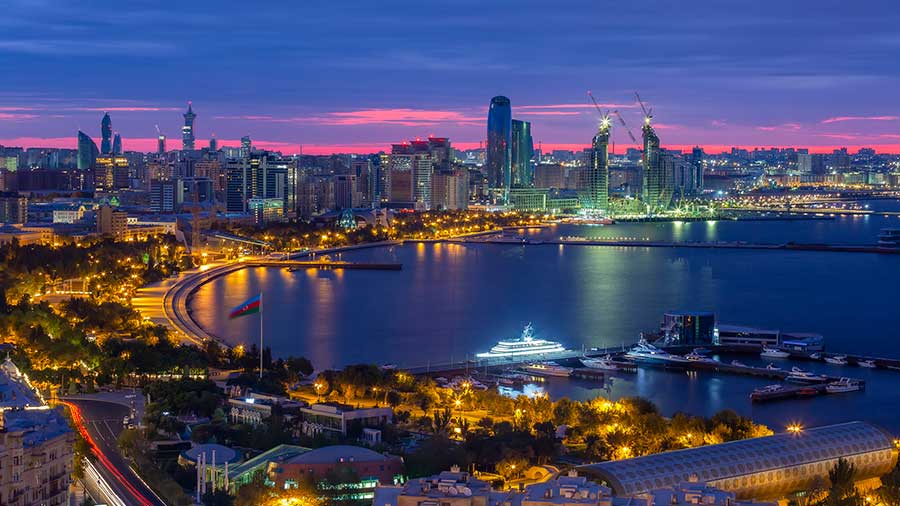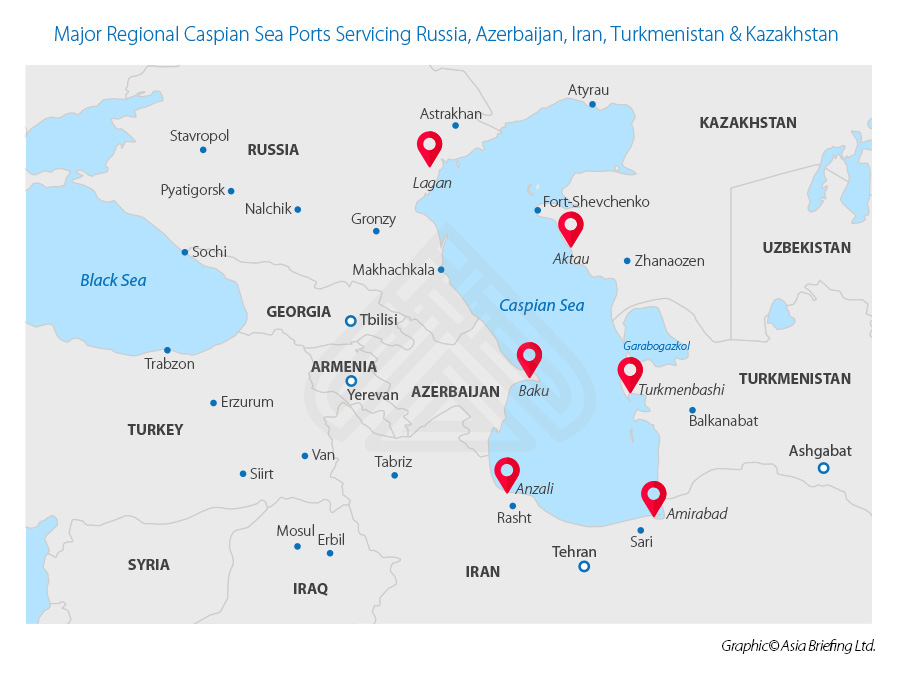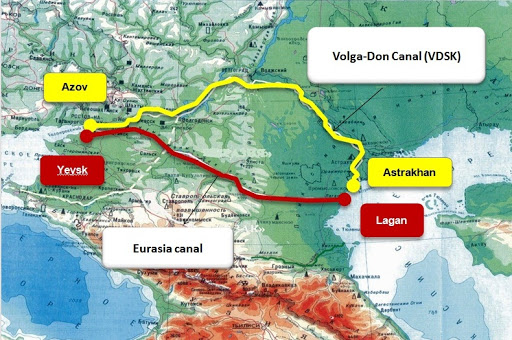Caspian Developing As Maritime, Haulage & Rail Hub Between Europe & Asia
Op/Ed by Chris Devonshire-Ellis

Baku City By Night
Infrastructure developments taking place in the Caspian region tend not to get much attention from Western media and business interests due to the on-off again relations between the West and Iran, Russia and China. However the Caspian Sea is becoming an alternative to the Suez option of shipping between Europe and Asia, and a great deal of activity is taking place.

Four major Belt & Road routes and one significant Indian route make up the five East-West intersections that the Caspian is shortly to provide, with the potential for a sixth should plans to create a canal between the Caspian and Black Seas come to fruition. We can examine each of these routes and the developing Caspian Ports as follows:
 The International North-South Transportation Corridor (INSTC)
The International North-South Transportation Corridor (INSTC)
The INSTC provides shipping access from India’s west coast Ports (dominated by Mumbai and Gujarat) and links them with Iran’s Chabahar port. The distance covered is 950 sea miles, or about 4 days journey time, and solves the Pakistan problem for India to its West, bypassing Gwadar Port. From Chabahar, goods are transferred to haulage and have two route options, a spur northeast leading to markets in Afghanistan, or directly north to the Iranian Ports on the Caspian, either Anzali Port (which is also a Free Trade Zone) or to the Amirabad Port. From there they can be transshipped again to Central Asian markets in Turkmenistan and Kazakhstan, or to Baku in Azerbaijan and connect to the BTK rail network through to the Caucasus, Turkey and Europe, or to the Russian markets via the new Lagan Port. Trade is likely to be brisk and especially in consumables, fabrics and certain household goods. This is because India’s middle class population has significant size (about 400 million), wealth, and has long romanticized about products from the West and Central Asia that used to be regularly traded prior to the partition of India and the creation of Pakistan. The INSTC recreates that trade capability with much-prized and previously accessible markets. See also: India & Russia Connect Via Iran’s INSTC
 Baku & The Baku-Tbilsi-Kars Route
Baku & The Baku-Tbilsi-Kars Route
Baku is a major Port on the western coast of the Caspian, and is well connected to other Caspian Ports in Iran, Kazakhstan, Russia and Turkmenistan. Shipping east to Kazakhstan’s Aqtau Port for example is a little under 300 nautical miles and takes just over 24 hours. Crucially, Baku also services the Baku-Tbilisi-Kars railway which crosses the Caucasus from Azerbaijan and onto Tblisi, the capital of Georgia, and heads to the Turkish border at Kars. From there goods can be distributed across Turkey, or head further east to Ports along the northern Turkish Black Sea coast, or onto Istanbul and then into the Mediterranean to South and South-Eastern Europe and markets in the EU. See also: Baku, The City To Watch As China’s Belt & Road Divides The Caucasus; The Baku-Tbilisi-Kars Railroad – Peace & Prosperity Through The Revival Of The Silk Roads and Turkey’s Pivotal Role In China’s Belt & Road Initiative In Europe, Central Asia and the Middle East
Meanwhile, the BTK also offers China an alternative route to Europe should relations with Moscow turn sour. Our article China Connects Rail To Europe Without Russia As BTK Route Runs South Via Caucasus & Turkey explains the rationale behind this and illustrates how canny the Chinese have been in building not just the Belt & Road, but options within that to protect and provide alternative supply chains.
Armenia meanwhile is somewhat left out of this, with political and military problems with Turkey to its immediate south and with Azerbaijan to its north. Here lie the Christian/Muslim religious fault lines. However, it has an ally with Georgia, and a proposed spur from the BTK route in expected to head down to Yerevan. See: Armenia’s North-South Highway Linking Europe With Iran, Dubai & India
 Lagan Port & Onto The Russian Volga River Heartland
Lagan Port & Onto The Russian Volga River Heartland
Russia has just released plans to redevelop the Port at Lagan, to make it deepwater and capable of handling larger container vessels. This has become necessary as the nearby Port of Astrakhan is silting up. Lagan is to be connected to rail and river networks intended to tranship goods up the Volga, as well as provide connections to other Caspian Ports.
The Volga River is the longest river in Europe with a catchment area of 1,350,000 square km. It is also Europe’s largest river in terms of discharge and its drainage basin. It flows through Central Russia and into the Caspian Sea, while eleven of the twenty largest cities in Russia, including Moscow, are located in the Volga’s drainage basin. Volgograd acts as a major city hub for the Volga, and is not only a River Port, but a railway junction served by the Privolzhskaya Railway. Rail connections from Volgograd include Moscow; Saratov; Astrakhan; in addition to Ukraine, the Caucasus and Siberia. The European Route E40, which connects with Calais to the West and Ridder in Kazakhstan to the east, also passes through Volgograd, as does the Russian M6 highway linking Moscow and the Caspian Sea. This makes Volgograd an important strategic and logistics hub along the Belt & Road and Eurasian Economic Union, one reason for the new highway and logistics developments taking part in the city.
Our article New Russian Caspian Lagan Port To Service China, India & Iran explains further, while the article Caspian Sea Agreement Opens The Volga River To Russia’s Interior Consumer Markets. details the extent of the reach into Russia that the Volga River provides.
 Aqtau Port, Kazakhstan’s Window To China & Caspian Routes
Aqtau Port, Kazakhstan’s Window To China & Caspian Routes
Aqtau Port is where goods from China intended to avoid the Trans-Siberian both for Belt & Road supply chain security and to reach alternative Central Asian and European markets cross Kazakhstan from China and reach the Caspian. From here they can be shipped directly to Russia’s Astrakhan Port and into the Russian heartland via transhipment up the Volga – Europe’s largest River at 3,531km. Eleven cities with populations in excess of 1 million lie along the Volga, which can carry shipping up to 10,000 tons. As discussed above, an alternative in via Lagan Port, while Aqtau is also convenient for access to Baku, and rail access to Turkey and onto Europe, as well as the Iranian Ports and onto India.
There is more on Aqtau Port in the article Aqtau Port, Kazakhstan’s Window Onto The Caspian Sea
 Turkmenbashi Port – The Turkmenistan Belt & Road To Deep Central Asia
Turkmenbashi Port – The Turkmenistan Belt & Road To Deep Central Asia
Turkmenistan – the closed, relatively unknown, yet exotic and potentially wealthy Central Asian nation is both rarely in the news, or accessible. Yet there are signs this may be slowly changing. Its Turkmenbashi Port is a significant opening to the West and trade with Russia, the Caucasus, Turkey and Europe. The Port opened in 2018, and has been affected by Covid-19 just as it was starting to get into operational stride. Yet it offers access to deep inside Turkmenistan itself, which has significant gas fields, as well easier access to markets in neighbouring Uzbekistan, itself going through something of a foreign investment renaissance, in addition to Afghanistan; becoming surrounded by countries such as China and India who wish to install peace and trade with it, while Iran lies to the south. Azerbaijan and Turkmenistan have agreed to look at an expansion of bilateral trade, while the Turkmenistan-Uzbekistan border is increasingly open for trade along its 1,793km length. Please see this article Turkmenbashi: Turkmenistan’s Caspian Window Onto The Belt & Road Initiative
A Caspian-Black Sea Canal?
The proposed Eurasia Canal is a 700 km canal which would connect the Caspian and Black Seas. Currently, a chain of lakes and reservoirs and the shallow irrigation Kuma-Manych Canal are along this route. The canal is intended to provide a shorter route for shipping than the existing Volga-Don network of canals, and would also require fewer locks. Much of the Manych Ship Canal would be redeveloped as the likely route for the Eurasian Canal. The proposal would expand and connect a series of rivers and waterways across the northern territories of the North Caucasus. The eastern end of the route would open to the Caspian along the Kuma River, at the border between Dagestan and Kalmykia; the western end would open into the Taganrog (Tahanrih) Bay, in the Sea of Azov, which itself connects to the Black Sea via the Kerch Strait. The nearby city of Rostov-on-Don would subsequently develop as a strategic maritime, rather than river port.
As a straighter and more direct riverine transit corridor than the pre-existing Caspian–Black Sea link—the more northerly, 17-lock Volga-Don Canal, the Eurasia canal would shave approximately 1,000 kilometers off the Volga-Don route and consist of only 6 locks. Additionally, the Eurasia canal could handle larger cargo vessels (10,000 tons, with a draft of up to 10 meters) compared to the Volga-Don Canal (5,000 tons, 5 meter draft), promising annual shipping capacities of as much 45 million tons.

The leading devotees of this project today are the Kazakhstan and Chinese governments. Such a canal would radically expand Kazakhstan’s foreign trade with Europe, especially bulk cargoes such as coal. Other Central Asian countries are interested as well but less focused on this project than Kazakhstan. The Chinese government is also supportive; yet, for Beijing, such a canal is not essential but rather an additional insurance policy should problems in the Indian Ocean restrict its ability to send most of its goods to European markets by sea. As noted above concerning Russia, China does not want to rely on any single route and, is developing not just one, but multiple routes between itself and the West. A navigable canal connecting Central Asia and Europe via the Caspian and Black Sea could be an essential part of that broader strategy.
The Russian government is at present less supportive. On the one hand, at least some in Moscow do not want to give Kazakhstan and other Central Asian countries yet another way to reach Europe without passing through European (northwestern) Russia, especially if the central Russian government would likely have to bear much of the cost for any canal. That said, Russia has completed the Kerch Strait Bridge – Europe’s longest – linking Crimea directly to Russia, and it may also prove politik to bring the canal into part of that infrastructure as well. A canal effectively linking Crimea to the Caspian Sea may bring tourism and trade benefits beyond the cost of building the canal, which has a price tag of about US$10 billion.
On the other hand, far more Russian officials today are worried about the environmental consequences as well as the political consequences that they might face if they ignored them. The merits of the project are still being debated. As always, it will be down to money – how much other countries are prepared to fund the route, against chargeable tariff usage income and RoI in terms of increased trade volumes. There is much pencil sharpening still to be done.
Executive Summary
Overall, this indicates that there is huge potential for investment and returns on that investment within the Caspian Sea logistics and supporting industries over the coming years. Five main national Ports on the Caspian sea all being redeveloped and upgraded, and numerous other auxiliary ports also being brought into the Caspian sea basin in terms of providing additional support.
This goes hand in hand with other Ports also due in time to see benefits and increasing trade as a result of what is going on in the Caspian region, with facilities being upgraded in Tblisi, Kars, and Ports along the Black Sea as far as Bulgaria and Romania (whose Constanta Port and outstanding Casino building are both well overdue for some serious investment).
The impact will also stretch east into the heart of Central Asia and Iran, and across to India. That the Caspian Sea will become a hub for shipping, rail and highway logistics between East and West and vice-versa is no longer in doubt. The question is that how far, in the face of Chinese and Russian investment and interest in the region, are European and other logistics and investment businesses prepared to get in on the act and secure their own piece of the Caspian trade development, and profit from this. Putting together costings and market intelligence should be part of the brief to understand how, where and when financing could be viable.
Related Reading
- Caspian Sea Agreement Paves the Way for Belt and Road Integration
- Free Trade Zones on China’s Belt & Road Initiative: The Eurasian Land Bridge
- Free Trade Zones Linking China, Russia & The Eurasian Economic Union
About Us
Silk Road Briefing is written by Dezan Shira & Associates. The firm has 28 offices throughout Asia, and assists foreign investors into the region. For strategic advisory and business intelligence issues please contact the firm at silkroad@dezshira.com or visit www.dezshira.com





